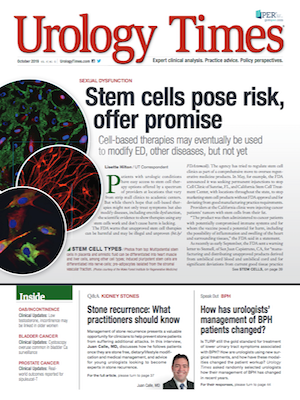Publication
Article
Urology Times Journal
Testosterone: A panacea for incontinence patients?
Author(s):
"Future research with urologist involvement, to isolate confounding factors and consider serum level variability and other hormone effects, will be useful," writes Priya Padmanabhan, MD, MPH.
Dr. Padmanabhan, a member of the Urology Times Editorial Council, is professor of urology, Oakland University William Beaumont School of Medicine, Royal Oak, MI.
Editor’s note: The abstract by Dr. Chancellor et al discussed in this editorial was selected for coverage in Urology Times by Dr. Padmanabhan while she was associate professor of urology at the University of Kansas Medical Center.
The significance of the “elixir of life” dates back to 1889 when Charles Edouard Brown-Sequard injected himself with liquid extracted from dog or guinea pig testicles. Testosterone has since been well studied for its anabolic, metabolic, and developmental properties in men and women. With the number of Americans 65 years and older doubling from 2018 to 2060, there is much focus on the effects of these associated hormone changes.
A large portion of serum testosterone is not biologically active. Total testosterone levels include both free testosterone and bound testosterone. Ninety-eight percent of testosterone circulates in the body bound to proteins (60% to albumin and 40% to sex hormone binding globulin). The remaining 2% is free (floating). Only the free and albumin-bound hormone are truly “bioavailable” to the cells.
There are multiple factors, such as smoking, obesity, and muscle mass, that impact total testosterone levels. Testosterone production has a circadian rhythm, which creates additional challenges for measurement. Testosterone levels decline in men, starting as early as 30 years, yet levels decline in women only after menopause. This decline has many associated signs and symptoms including, but not limited to: change in sleep patterns, worsening of sleep apnea, and physical, sexual, and emotional changes.
Read: Positive dipstick does not preclude BTX injections
A recent study from Michael B. Chancellor, MD, of Oakland University William Beaumont School of Medicine assessed the correlation between decreased testosterone levels and urinary incontinence in older women who participated in the Health, Aging and Body Composition Study (see article here). Nearly half of women >50 years of age experience incontinence, which continues to increase with age. Androgen receptors throughout the pelvic floor and lower urinary tract play an important role in pelvic floor musculature and function.
Prior studies have alluded to the diminishing effects of low testosterone on the pelvic floor musculature, yet the relationship between postmenopausal testosterone level and incontinence is unknown. This study was successful in collecting data from a large, healthy group of women and men 70-79 years old. Measurement of serum free testosterone and total testosterone was performed along with quality of life surveys and self-reported daily urinary leakage. The collection of free testosterone is important for the detection of bioavailable testosterone.
Results indicated that serum testosterone is decreased in women with urinary incontinence less than once per month and showed a trend toward higher free testosterone in women with incontinence more than once per month.
It is challenging to study the impact of testosterone level alone on postmenopausal incontinence, given the equally significant effects of diminished estrogen. The circadian rhythm and overall lower concentration of testosterone in women limits the reliability of measurement.
Ideally, free and total testosterone should be drawn first thing in the morning and at alternate time points to ensure reliability of the test results. With involvement of urologists in the future, confounding factors-smoking , obesity, sleep patterns-should also be included in the evaluation to more accurately reflect the correlation.
Hormone replacement has become a fad, with creams, gels, and troche being created like designer jeans. Incontinence represents an expensive, multifactorial, health care beast. Testosterone replacement is not a panacea for incontinence. Future research with urologist involvement, to isolate confounding factors and consider serum level variability and other hormone effects, will be useful.
We want to hear from you! Send your comments to Dr. Padmanabhan c/o Urology Times, at urology_times@mmhgroup.com































